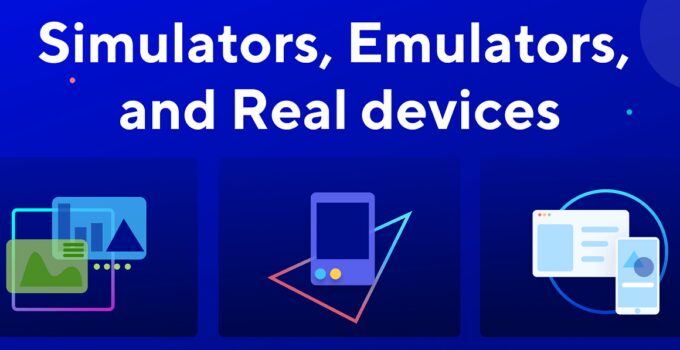Mobile app and web testing have always been crucial in the development process. Testing is all about identifying and fixing flaws, including fundamental font size differences, navigational hiccups, sign-up form flows, and payment processing errors. A thorough testing of apps ensures that any modification to the app build does not impair the user experience on various devices.
The instruments used for testing mobile apps are an essential component of a strong testing procedure. A comprehensive testing process may also produce inconsistent findings on various hardware. Therefore, the device on which we test becomes a relevant parameter that is crucial to ensure the quality of apps. Because mobile devices come in various varieties with varying operating systems, browsers, and hardware specifications, testing on these devices is even more critical.
What are Emulators?

Source: lifewire.com
A software that replicates the hardware and OS config of the intended device on your computer is known as an emulator. They accomplish this by employing binary translation to convert the target device’s ISA (Instruction Set Architecture) to the one that the computer you are using to perform testing uses.
Each processor family has its own set of instructions, known as ISA, that are defined in machine language and utilized to construct device configurations that represent the features and actions of the device.
You may create a virtual testing environment by simulating the functionality of your target device by translating the target mobile device’s ISA into your PC.
Nevertheless, the delay is a trade-off for these near-native features of the target mobile device, which let you modify the physical sensors, geolocation, etc.
Some of the most popular emulators for testing mobile apps include those for Android and IPhone (which is a misnomer for iOS Simulator).
What are Simulators?
A simulator is software that enables your computer to execute specific applications designed for another operating system. Unlike readily mimicked Android devices, they are primarily intended for iPhones and iPads.
The iOS simulator testing sits on top of the computer’s operating system, mimicking iOS and running the necessary applications therein. However, because the iOS emulator requires Apple’s native Cocoa API, it can only be used on macOS. The GUI, runtime, and several other functions depend on this Cocoa API. Developers are forced to work on the MacBook or virtualize macOS on their current systems, which presents a problem of latency and various other failures.
Simulators do not replicate hardware, in contrast to emulators. As a result, while utilizing simulators, one cannot look at specific capabilities like battery use, cellular interruptions, etc.
What is a Real Device?

Source: techbeacon.com
Several mobile phone models utilized to evaluate the website or app’s functionality and behaviour patterns are known as real testing devices. These are real devices that the customer would use.
Testing teams typically purchase a few mobile devices, such as tablets, iPads, Blackberry, Android, and iOS phones, for testing mobile apps.
Real Device Testing vs. Virtual Testing Device
One fundamental characteristic that unites simulators and emulators is that they are virtual devices rather than real devices in real environments. With regards to testing apps for mobile devices, the critical distinction is between real device testing and virtual environment testing.
Installing the most recent version of a mobile app on a real device allows you to evaluate its integrations, functionality, and interactions in real-world scenarios. This process is known as “real device testing.” A thorough mobile app testing plan should include real device testing, especially with virtual devices (i.e., iOS simulators and Android emulators).
Since emulators and simulators are often software-driven, they can be provisioned more quickly than real devices. They also make test automation and parallel testing possible with external frameworks like XCUITest, Appium, and Espresso.
Parallel testing is made possible via emulators and simulators, this can also be conducted in a lab-based device setup like pCloudy. With just a few clicks, devices may be used to perform the tests in parallel without manually setting up each one.
If mobile QA teams begin using emulators and simulators, they could go so far as to cease using real devices for testing. This might expedite testing, but there’s a big catch: emulator app testing and simulators can’t accurately mimic device hardware. This makes utilizing an emulator or simulator to test against real-world circumstances challenging. An emulator or simulator cannot simulate problems with the kernel code, device memory, Wi-Fi chip, layout modifications, or other aspects unique to a particular device.
Hence it becomes important to test your apps using real device testing methods to make the most of quality application releases. This helps you maximize the results of your efforts and accuracy. While testing on emulators and simulators offers better mobility, the other guarantees more accurate test results.
Real Device Vs Emulators Vs Simulators

Source: knowtechie.com
| Criteria | Real Devices | Emulators | Simulators |
| Performance | Accurate representation of real-world performance. | It may not accurately replicate real device performance. | Performance may not be completely accurate. |
| Operating System Versions | Provides testing across various OS versions and manufacturers. | Emulators typically support a range of OS versions but may not perfectly mimic all nuances. | Simulators replicate OS behavior, but may not capture all intricacies. |
| Installation of Apps | Real apps can be installed and tested in the same way as on a user’s device. | Emulators can run apps directly, but installation may differ slightly. | Simulators can run apps directly, but installation may differ slightly. |
| Availability | Limited availability of devices for testing. | It is widely available and can be easily configured. | It is widely available and can be easily configured. |
| Accuracy of Testing | Most accurate representation of real-world scenarios. | It may not catch all issues due to differences in hardware and emulation. | It may not catch all issues due to differences in simulated environments. |
| Network Conditions | Realistic testing of different network conditions. | It may not fully replicate real-world network conditions. | It may not fully replicate real-world network conditions. |
| Integration with IDEs | It is easily integrated with most IDEs. | Integrated with popular IDEs, but setup may require additional configuration. | Integrated with popular IDEs, but setup may require additional configuration. |
Conclusion
Mobile apps are so crucial to our daily lives, and testing mobile apps is becoming more and more critical. Selecting the appropriate tools is one technique to accomplish the specified objectives, even though a lot of testing is necessary (actual devices, simulators, and emulators). Combining these technologies is the best approach to developing an excellent testing solution that will save you time, money, resources and provide a higher return on investment.







